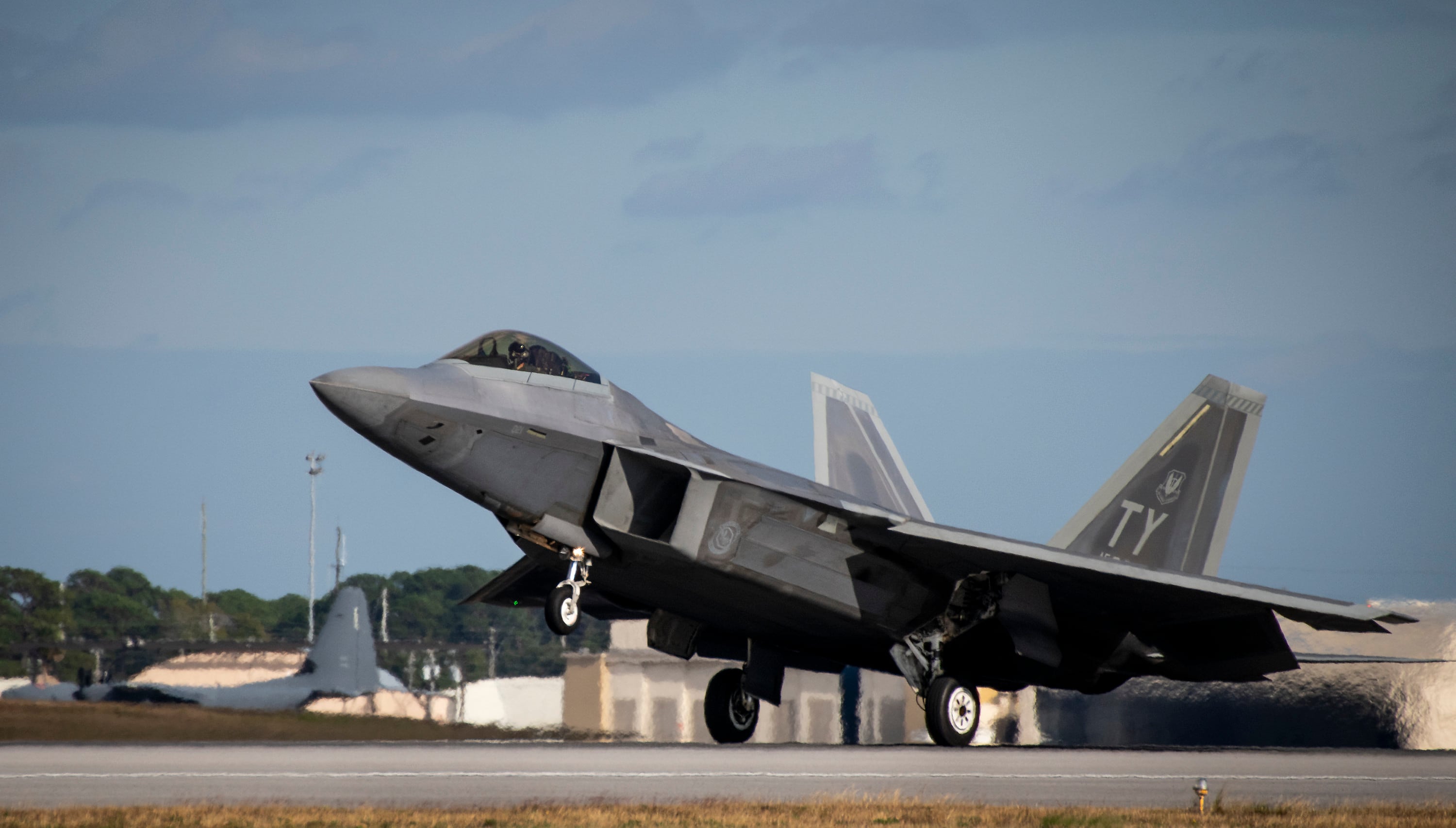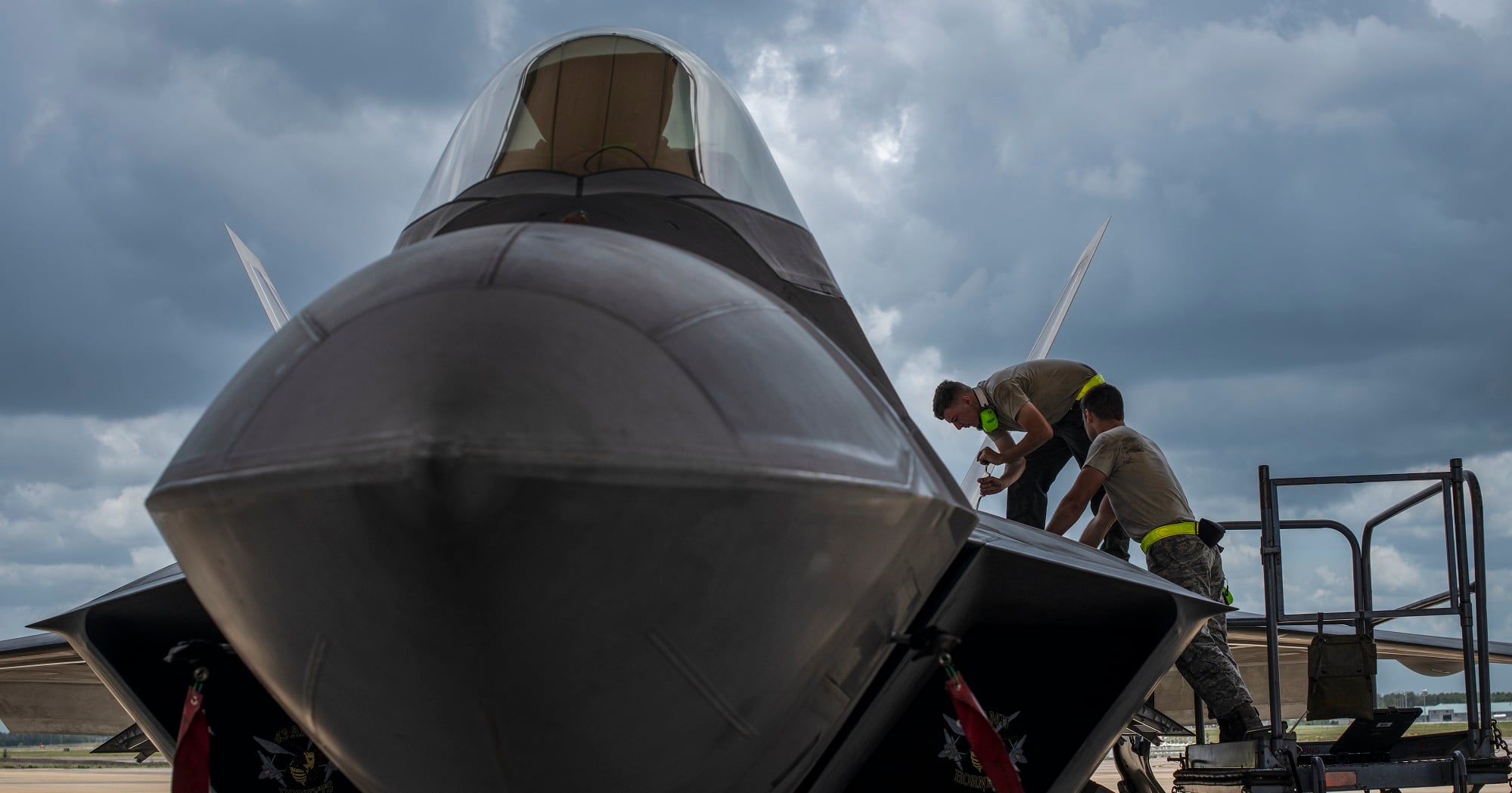Newly obtained documents offer a clearer picture of an F-22 Raptor’s demise in Florida last year when it crashed near Eglin Air Force Base during training with other fighter jets.
The F-22 grew increasingly wobbly upon takeoff, refused to turn left and shortly barrel-rolled into the ground after its pilot safely ejected, according to the Air Force’s investigation into the May 15, 2020, incident that was not previously made public.
Air Force Times received the safety board investigation documents through a Freedom of Information Act request.
RELATED

The Air Force said earlier this year that it did not convene a longer-term accident investigation board to look into the crash, instead waiving that usual requirement because of operational security concerns. A commander-directed investigation and a safety investigation board took place instead, and much of the paperwork obtained dates to June 26, 2020.
The inquiry’s findings detail a harrowing morning at Eglin’s test and training range as the pilot struggled to control and then bailed out of one of the Air Force’s most advanced airframes. A confusing mission to inspect the crash site and find the pilot nearly resulted in another collision between an F-22 and an F-35 Lightning II.
The unnamed pilot was a captain serving as the 43rd Fighter Squadron’s assistant operations director. He flew as “Hornet 1″ that day in a large-force air combat exercise with six F-35s, four F-16Cs and three F-22s, according to the investigation.
The 43rd FS is the only Air Force unit that provides initial and requalification training for active-duty, Air National Guard and Air Force Reserve F-22 pilots.
Upon takeoff around 8:30 a.m. local time, Hornet 1′s cockpit flashed a warning notice as the jet picked up speed. No other issues popped up as the plane went airborne, so the pilot decided to keep going.
After rising about 50 feet, the airplane began to tilt to the left.

“I thought maybe I had an afterburner blowout on a left motor,” the pilot told investigators. They scaled back the throttles and the jet leveled out. Another captain flying as “Hornet 2″ said both engines appeared to be in good shape, and nothing else seemed amiss.
The Raptor’s nose pointed about 45 degrees toward the sky, and another warning message came up to signal degraded air data. At the same time, the jet again started to roll left and pitched down without warning.
His F-22 was “almost inverted,” the Hornet 2 captain said.
“I thought that I was out of control at that point and was concerned that I might have to eject right there,” the pilot said.
The pilot righted the aircraft once more. Everything seemed normal, the pilot said, and they continued with the training exercise. But the situation deteriorated quickly.
Another cockpit warning told the pilot that g-forces were overly stressing the plane, the third alert of the flight. He decided to try to safely put down the F-22 by burning off fuel on the way back to the ground and landing on the longest runway.
“As I passed 10,000 feet, the jet began to have uncontrollable tendencies again … a barrel-roll type feel,” the pilot said. “It took a majority of the pressure I had available in my right arm to keep the airplane in level flight, and then at that point I could no longer turn left.”
RELATED

The pilot then noticed the cockpit display showed a higher altitude and speed than what a nearby wingman reported. Fearing the jet could no longer be trusted, the pilot decided to eject.
Time slowed as the pilot launched out of the cockpit, watching the jet’s canopy fall through the air in a daze. Hornet 2 looked on as the F-22 spiraled down and slammed into the ground.
“Looking down, I thought, ‘Oh, there’s a forest fire down there,’” the pilot said. “Then I realized that, no, that was actually where my airplane landed. … I began attempting to steer towards the clearing and avoid the fireball.”
F-35s flew to the scene to relay coordinates to search-and-rescue forces, but none were available from Duke Field, Hurlburt Field or the surrounding local area, according to another captain, an instructor with the 43rd Fighter Squadron who served as the flying supervisor during the mishap.
The downed pilot landed in shrubbery within about 100 yards of a nearby road and hitched a ride back to Eglin in a government-owned vehicle that had pulled up. His calves were sore and his hands scratched, but otherwise felt fine, a lieutenant colonel working as the sortie operations supervisor told investigators.
A local tour helicopter was en route to help find the pilot while military personnel were on their way, but was called off when the pilot confirmed to local officials that he was OK. Some U-28 special operations reconnaissance planes from Hurlburt took over at the scene once the F-35s ran out of gas, the flying supervisor said.
“There were multiple [air traffic control] agencies that I believe were attempting to help using their best judgment, but the airspace over the crash site actually got saturated and became … fairly dangerous,” the supervisor said.
F-22s flying overhead almost collided in midair with F-35s that were acting as the on-scene commanders — a near miss that the supervisor said should be a learning opportunity for future emergency response coordination in the area.
In total, the accident cost more than $202 million in damages, including the $201.6 million aircraft, two CATM-9 air-intercept training missiles valued at $32,000 apiece, and $850,000 in environmental cleanup costs.
The pilot was not fatigued, stressed or intoxicated at the time of the accident. Investigators also spoke with F-22 manufacturer Lockheed Martin and other companies that work on the jet, though their input was not made public.
After more than a year of silence on the mishap, the Air Force said in August the jet crashed because of a “maintenance error made after the aircraft was washed” that “impacted control inputs transmitted to the aircraft.” The service did not elaborate on that error; the investigation documents do not include interviews with maintainers or other clear evidence of a cause.
RELATED

A spokesperson for Air Combat Command did not answer whether other Raptors could be affected by the same issue, or whether the investigations have led to further inspections or repairs.
The 43rd Fighter Squadron is part of the 325th Fighter Wing that relocated from Tyndall AFB, Florida, to nearby Eglin when Hurricane Michael destroyed the base in 2018. The wing has struggled with staffing and morale in the years since the hurricane as airmen feel stuck in limbo between Tyndall and a potential move to Joint Base Langley-Eustis, Virginia.
Nearly half of the nine major F-22 mishaps in fiscal 2020 occurred at the 325th Fighter Wing, including the May 2020 incident.
Rachel Cohen is the editor of Air Force Times. She joined the publication as its senior reporter in March 2021. Her work has appeared in the Washington Post, the Frederick News-Post (Md.), Air and Space Forces Magazine, Inside Defense, Inside Health Policy and elsewhere.





